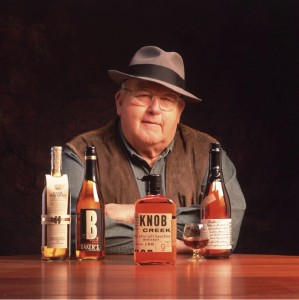I can’t stress this enough. Booker Noe was an incredible man.
The titans that paved the way for the modern bourbon age that we find ourselves in were not CEOs or marketing strategists. They were country boys with a love for bourbon. Before Prohibition, wealthy tycoons like Colonel Blanton, Colonel E.H.Taylor, Isaac Wolfe Bernheim and Samuel Bronfman led the way. After the bourbon collapse of the brown spirits market in the 60’s and 70’s, it was largely the perseverance of a few (now legendary) Kentucky distillers that brought bourbon back. Booker Noe was one of those men.
Frederick Booker Noe II was the grandson of the famous Jim Beam. He was born in 1929 and was the son of Jim Beam’s daughter, Margaret Noe. Booker began helping at the distillery as a teenager and, after attending the University of Kentucky, returned in 1950 to work as an assistant distiller. For over 40 years, he worked as distiller at the Jim Beam Company Distillery in Boston, Kentucky. In 1965, when Booker was named master distiller, Jim Beam may have been the best-selling bourbon in the world, but under his direction, production increased twelve-fold!
In the 1980’s single malt scotch was gaining traction in U.S. sales and the bourbon industry needed to compete. Booker Noe had been bottling and serving guests at his home his uncut, unfiltered Booker’s bourbon, but in 1992, he would introduce his product to the American public. The Jim Beam Small Batch Collection was his contribution to the bourbon world, and that is no small thing. The term “small batch” was new and the four small batch collection bourbons that Mr. Noe created were a response to Elmer T. Lee’s single barrel bourbon expression- Blanton’s. It was the creativity and innovation behind these four whiskeys (not to mention Mr. Lee’s Blanton’s Single Barrel Bourbon) that boosted the bourbon market as a whole.
Booker’s was the first of the four small batch releases, being the whiskey that Booker Noe had originally only bottled for himself. It was the first uncut, unfiltered (it will cloud when put on ice) bourbon ever released. Basil Hayden, named after a distiller from the 18th century that used a larger amount of rye in his mash, was designed to appeal to Canadian whiskey drinkers. It is the lightest of the four bourbons and uses the Old Granddad recipe. Baker’s is named after Booker Noe’s uncle, who was distiller at Beam’s Clermont facility. Baker’s Bourbon is 107 proof and lower than Booker’s, which is closer to 129 proof, and it uses the same recipe. It was designed to create stronger bourbon cocktails. Knob Creek was named after a local town and was meant to appeal to the bonded bourbon drinker at 100 proof. Each whiskey was designed to expand the available styles of bourbon on the market and create a demand from drinkers and collectors alike. It worked.
Though Booker Noe retired in 1992, the same year as the small batch bourbons were released, he went on to become a spokesperson for the company and traveled all over the world promoting his new whiskeys. He was an imposing man at 6’4” and was very entertaining. His personality gained him a great deal of popularity, and he became a rock star in the bourbon world. He was one of the eight original inductees into the Kentucky Bourbon Hall of Fame in 2001. He spent about a decade in his ambassador role, but, sadly, fell ill in his early seventies. Booker Noe passed away on Feb. 24th 2004 at the age of 74. He will always be remembered, and bourbon drinkers the world over (including myself) are very thankful that his experience and expertise will be passed down and shared by bourbon makers for generations to come.

